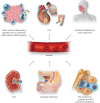Anemia in the Elderly
- PMID: 31723768
- PMCID: PMC6745992
- DOI: 10.1097/HS9.0000000000000040
Anemia in the Elderly
Abstract
Anemia affects a substantial fraction of the elderly population, representing a public health problem that is predicted to further increase in coming years because of the demographic drive. Being typically mild, it is falsely perceived as a minor problem, particularly in the elderly with multimorbidity, so that it often remains unrecognized and untreated. Indeed, mounting evidence indicates that anemia in the elderly (AE) is independently associated with disability and other major negative outcomes, including mortality. AE is generally multifactorial, but initial studies suggested that etiology remains unexplained in near one-third of cases. This proportion is consistently declining due to recent advances highlighting the role of several conditions including clonal hematopoiesis, "inflammaging," correctable androgen deficiency in men, and under-recognized iron deficiency. Starting from a real-world case vignette illustrating a paradigmatic example of anemia in an elderly patient with multimorbidity, we review the main clinical and pathophysiological aspect of AE, giving some practical insights into how to manage similar cases.
Copyright © 2018 the Author(s). Published by Wolters Kluwer Health, Inc. on behalf of the European Hematology Association.
Figures


References
-
- Blanc B, Finch CA, Hallberg L, et al. Nutritional anaemias. Report of a WHO Scientific Group. WHO Tech Rep Ser 1968; 405:1–40. - PubMed
-
- Beutler E, Felitti VJ, Koziol JA, et al. Penetrance of 845G--> A (C282Y) HFE hereditary haemochromatosis mutation in the USA. Lancet 2002; 359:211–218. - PubMed
-
- National Center for Health Statistics. Plan and operation of the Third National Health and Nutrition Examination Survey, 1988–1994. Vital Health Statist. 1994:1–407. - PubMed
Publication types
LinkOut - more resources
Full Text Sources
